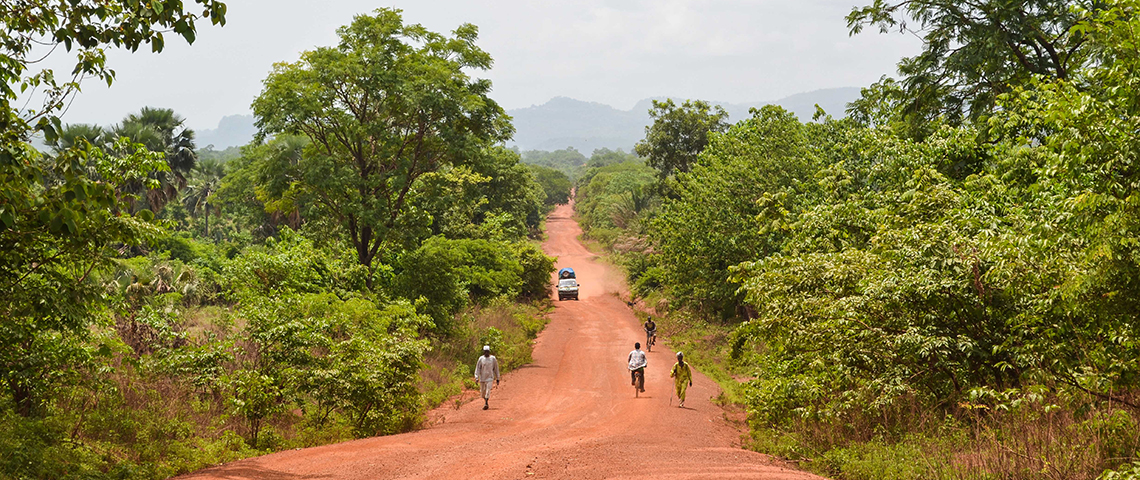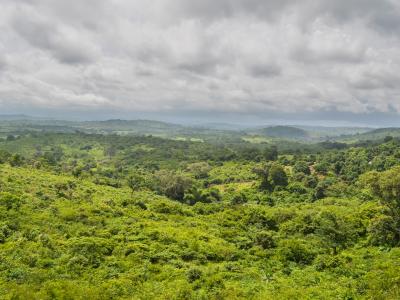
Despite considerable natural resources, including rich biodiversity, fertile soil, forests and mineral deposits, the West African nation of Guinea remains one of the world’s least developed countries due in part to the poor management of climate variability over past decades.
In line with climate change, the country has seen a decline in rainfall, recurring droughts since the 1970s, and frequent and early floods. The observed impacts of these disturbances are the drying up of many rivers and soils, the reduction of vegetation cover, a decline in agricultural, pastoral and fishing production, and the resurgence of waterborne diseases, all exacerbated by unsustainable production systems.
National development strategies are struggling to achieve results while the country is still recovering from the devastating effects of the 2015 Ebola virus disease.
By improving climate monitoring, forecasting and early warning for disasters, and strengthening the capacities of key actors, this four-year project (2019-2023) will help Guinea to respond to shocks and to mainstream adaptation into development planning for climate-sensitive sectors (agriculture, livestock, water, coastal and forestry areas) – supporting more inclusive and sustainable development into the future.
- National
- Country Office
- National Governments
- Non-Governmental Organizations
- United Nations Development Programme (UNDP)
9,600,000 individuals (80 per cent of the Guinean population) who are currently affected by the effects of climate change in the agriculture, fishing, livestock farming, mining and forest industry sectors. Approximately 200,000 will be direct beneficiaries and around 51 per cent of the beneficiaries will be women. | Grassroots community organizations and farming associations | Over 120 political decision-makers from the agriculture, fishing, livestock farming, mining and forest industry sectors as well as from the planning and finance sectors.
- United Nations Development Programme (UNDP)
A coastal country bordered by Côte d'Ivoire, Mali, Liberia, Sierra Leone, Guinea Bissau, Senegal and Mali, Guinea is at the crossroads of major West African climate groups including the Guinean coastal climate, the Sudanese climate and the wet tropical climate at the edge of the equatorial climate.
For several successive decades, the country has recorded a considerable decline in rainfall over the entire territory. This decline has been accompanied by a general rise in temperatures, recurring droughts since the 1970s, a decline in the frequency and intra-annual distribution of rainfall, early and frequent floods, and sea-level rise.
The effects of these changes is having negative consequences for many rural development sectors still largely dominated by rainfed activities and for communities already living under precarious conditions.
By expanding hydrometeorological infrastructure and strengthening institutional capacities in climate monitoring, early warning and development planning, this project is aimed at reducing vulnerability to shocks and promoting climate adaptation in Guinea’s most exposed sectors.
The project feeds into national and global priorities including Guinea’s National Economic and Social Development Plan (PNDES) 2016-2020, Vision Guinée 2040, Guinea’s National Adaptation Programme of Action (2007) and the country’s Intended Nationally Determined Contribution (2015) submitted to the UNFCCC under the global Paris Agreement.
It cuts across several Sustainable Development Goals in Guinea, including SDG 7 (Gender Equality); SDG 12 (Sustainable Consumption and Production), SDG 13 (Climate Action) and SDG 15 (Life on Land).
COMPONENT 1: Technology transfer for monitoring climate and environmental infrastructure
Outcome 1: The capacities of the national hydrometeorological departments are strengthened in monitoring extreme weather phenomena and climate change
Outputs:
- 64 hydrological stations with telemetry, processing and archiving of data rehabilitated/installed and operational.
- 37 automatic weather stations, 1 upper air station and 24 lightening detection sensors with archiving and data processing facility rehabilitated/ installed
- A training program for the efficient operating and maintaining of the hydrometeorology equipment is developed and delivered to hydrological and meteorological technicians of the National Directorate of Meteorology and National Directorate of Hydraulics
- A training program to run hydrological models and produce climate information products and services (including early warning information) is delivered to meteorologist engineers and hydrologist engineers of the National Directorate of Meteorology and National Directorate of Hydraulics
- A centralized national climate data and hazard information center and knowledge management system is set up
COMPONENT 2: Integrating climate information, early warning and climate adaptation products into development plans.
Outcome 2: The generated climate products and services are accessible and used efficiently and effectively for the production of warnings for producers and in the drafting of medium- and long-term climate-resilient development plans
Outputs:
- Risk profiles and maps for floods, landslides, thunderstorms, bushfires, stormy winds, and droughts, malaria and meningitis (length of transmission period and geographic range), risk zoning based on hazard and risk maps for all ecological regions of the Guinea, the key river basins, agrometeorological bulletins, rainy season outlooks are developed
- Hazards risks and climate information products and services are integrated in the multi-year investments plans of the agricultural, water, environment and health sectors, the national land use plan, the national disaster risks management strategy and the local development plans of 26 municipalities
- A multi hazards Early Warning System covering all Guinea is developed and operational
- A financial sustainability strategy for the Early Warning System and the centralized national hydroclimatic data and hazard information and knowledge system is developed
Inception workshop, August 2019.
Project results are monitored annually and evaluated periodically during project implementation in compliance with UNDP requirements as outlined in the UNDP POPP and UNDP Evaluation Policy. Additional mandatory GEF-specific M&E requirements are undertaken in accordance with the GEF M&E policy and other relevant GEF policies. Further M&E activities deemed necessary to support project-level adaptive management will be agreed during the Project Inception Workshop and will be detailed in the Inception Report.
The Project Manager is responsible for day-to-day project management and regular monitoring of project results and risks, including social and environmental risks. The UNDP Country Office supports the Project Manager as needed, including through annual supervision missions.
The Project Board holds project reviews to assess the performance of the project and appraise the Annual Work Plan for the following year. The Board will take corrective action as needed to ensure results.
In the project’s final year, the Project Board will hold an end-of-project review to capture lessons learned and discuss opportunities for scaling up and to highlight project results and lessons learned with relevant audiences. This final review meeting will also discuss the findings outlined in the project terminal evaluation report and the management response.
The UNDP Country Office will retain all M&E records for this project for up to seven years after project financial closure in order to support ex-post evaluations undertaken by the UNDP Independent Evaluation Office and/or the GEF Independent Evaluation Office.
Key reports:
- Annual GEF Project Implementation Reports
- Independent Mid-term Review and management response
- Independent Terminal Evaluation
- UNDPJulien SimeryTechnical Specialist - Climate Change Adaptation

